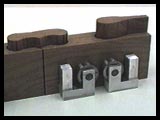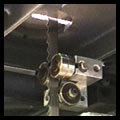

Tool Review - 14"Bandsaw Blade Guides continued
Given what we know, the questions remain - do we really need these products and if so, which one is best for us? To find out, I used all three bearing guides in my shop over the course of two months. Most of the testing was done haphazard depending on the task at hand and included some tight scrolling as well as resawing some 5" wide oak boards. Since the Carter guides were the most difficult to install and remove, they stayed in the saw the longest.
Upper Guides
Anyone who has owned a bandsaw for a while knows what I mean
by marginal blades. These are blades which are sharp enough for
busting out plywood ribs for a form, but they have lost their
initial edge. Trying to resaw wide oak leaves them wiggling in
the cut, oscillating from side to side giving us anything but
a straight board. My WoodSlicer is
one of these blades and I tried to resurrect it from the back-up
pile to see if these guides could tame it's wandering ways. None
did.
Bottom line, don't expect these guides to bring back dying blades. It won't happen. The forces involved are just too great. Bearing guides only restrict sideward deflection of the blade at the center where the bearings come together. Once past this tangent, blades are free to roam. The further the center is from the wood, the more freedom the blade has. The larger the bearing, the larger the distance the blade travels unrestricted. This is not such a problem for the hardened blocks which came with my bandsaw. Though the bearings did pretty well, even the best of them allowed at least 1/4" more free-space than the blocks.
Where bearings do have an advantage, in this area, is the durability of their side-to side restriction - bearings just won't wear out!. I've used bandsaws which don't have hardened blocks as guides; some even have plastic guides. These blocks quickly erode and lose any pretense of restricting the blade's wandering. The fix is to remove the blocks and reface them on a grinder or with a file. Installing a set of bearings should free you from this inexact task.
Lower Guides
 Another thing
I looked at was Joe Johns' contention you don't need to replace
the lower guide blocks if your blade is sharp and well tensioned.
I think he's correct as long as your lower guide blocks are hardened.
I didn't see any advantage here in accuracy either between his
top only bearings and the upper/lower sets offered by Iturra
and Carter. I did some scrolling in 6/4 walnut with a 1/4"
blade and could see no deviation from plumb using his top-only
setup. My lower guide blocks, which I can never recall having
refaced, did just fine in keeping the lower half of the blade
true to the cut.
Another thing
I looked at was Joe Johns' contention you don't need to replace
the lower guide blocks if your blade is sharp and well tensioned.
I think he's correct as long as your lower guide blocks are hardened.
I didn't see any advantage here in accuracy either between his
top only bearings and the upper/lower sets offered by Iturra
and Carter. I did some scrolling in 6/4 walnut with a 1/4"
blade and could see no deviation from plumb using his top-only
setup. My lower guide blocks, which I can never recall having
refaced, did just fine in keeping the lower half of the blade
true to the cut.
 In fact, if
you look at this picture of the lower Carter guides again, you'll
see the bearings sit quite a bit lower than the table than my
Delta's original setup and the replacement bearings from Iturra.
The Carters don't start to guide the blade until you get 2 1/4"
below the table surface; about one inch for the original guide
blocks and 1 1/4" for the Iturra Bandrollers.
In fact, if
you look at this picture of the lower Carter guides again, you'll
see the bearings sit quite a bit lower than the table than my
Delta's original setup and the replacement bearings from Iturra.
The Carters don't start to guide the blade until you get 2 1/4"
below the table surface; about one inch for the original guide
blocks and 1 1/4" for the Iturra Bandrollers.
Another thing I noticed when looking at this picture, was the way the bearings formed a funnel in directing debris toward the blade. I didn't have any incidents of trash forcing it's way into the gap between the blade and the bearings but the potential is there.
I have seen this happen on other saws without a tight throat insert. When I was part owner of a bandsaw mill, this was one of our major causes of blade breakage. We used deflector plates to channel larger chunks away from the bearings. If I kept the Carter's, I would definitely replace my throat insert with a tight piece of wood to keep debris away from the bearings. This isn't necessary when using the original guide blocks since they act as their own deflectors to keep trash out.
Heat
We all know the effects of friction
on our sharp cutting edges. Friction causes heat and heat softens
metal. It's natural to assume a running bandsaw blade rubbing
up against a steel guide block might generate some damaging heat.
One of the advantages we find when considering bearing guides
is they don't rub against the blade and perhaps don't allow heat
to build up to the point of annealing the saw teeth or the back
of the band.
To test the effects of heat, I picked the gnarliest looking blade from my pile and mounted it on the saw. Fully expecting this test to ruin the blade, I threw caution to the wind and tensioned this puppy well beyond the limits I normally observe. It was tight!
The test was simple: back off the bearing from one side at the top assembly and shove the opposite bearing as far out of alignment into the blade as possible. Turn the saw on.... for an hour or two....while I did something else.....fully expecting to hear that BANG when the blade breaks from .... whatever.
It didn't happen. In fact, all three bearings came through this test with flying colors. Even when I turned the saw off and touched the bearings, one would have expected them to be too hot to touch. Not so. Lukewarm maybe but not even close to hot. There wasn't any need to get out my atomic powered digital thermometer. Heat just wasn't going to be an issue. Since the bearings were so cool, I imagined it possible the 3/8" blade may have acted to draw some of what little heat was created away from the bearings with the rest being absorbed by the air and the bandsaw. It's hard to say.
To find any advantage for the bearings, I tried the same test on one of my steel guide blocks; it too was tightened hard into the blade. Oddly, and completely by surprise, the result was the same plus my old blade was getting a pretty nice polish on one side thanks to it's constant contact with the steel. It started to look new again...:)
Certainly this test is far from scientific. It may be possible during heavy resawing that contact with the thrust bearing could create enough heat to damage a blade. Perhaps heavily twisting a blade during a tight curve can pinch out enough heat to cause problems. I don't know but I seriously doubt it. I suspect blades suffer far worse in the cut and having one guide system or another isn't going to affect a blade's longevity anywhere near as much as how hard a wood you're sawing. If there is any advantage here it would have to go to the Carter's because of their thrust bearing configuration. But one could equally argue that the Johns slower moving bearings generate less heat. Who knows?
Recommendations
First off, most woodworkers with durable, tool steel blade guides
needn't lose any sleep over having any of these bearing replacements.
If there are any advantages to the bearings, I couldn't see them
unless the bearings are quieter. I really didn't notice.
If you have guide blocks which are easily
scored by your bandsaw blades, you might consider replacement
guides depending on what types of woodworking you do. The Carter
guides are the sweetest with their turned thrust bearing, but
their price makes them hard to justify for all but the most dedicated
bandsawyer. Especially when you consider that mounting the Carter
kit will make reinstallation of Cool Blocks, for narrow bands,
very tedious. Perhaps if you run expensive carbide-tipped blades
in a production setting, the Carter's may earn their keep.
I'd like to see them offer a top-only set of bearings which let
you keep the original adjustment mechanism or incorporate a couple
thumbscrews in their own design. Maybe swap out the lower bearings
for some of their Teflon-impregnated blocks which tuck up closer
to the table and sell all for less than $100. I'd like to win
the lottery too...:)
The comparison between the Iturra and the Johns bearings is somewhat of a toss-up. The Ittura bearings are the smallest so they aren't apt to last as long but you won't have to sacrifice any resawing capacity. If you're having problems with your bandsaw you think adding bearings will fix, the literature provided might help you figure it out. If resawing is your game and you know when to replace a dull blade, the Iturras should do just fine.
If scrolling with a 1/4" blade is your bag, I like the Johns bearings the best. I almost never need more than 5" of cutting height and something about pinching the blade tight between the bearings really appealed to me.
Respectfully submitted,
Jim Mattson
Update as of 2009 - I've lost current contact information for both Joe Johns and Louis Iturra. :(
The Carter bearings are still available separately for top and bottom, and they
have kits for many other saws at their website.